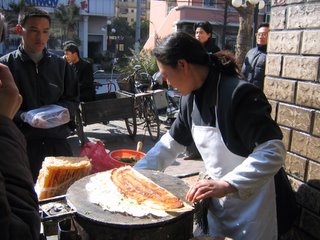Street food is everywhere but history and food are nicely combined at Yuyuan Garden. Tourists are drawn to Yuyuan Garden for its picturesque buildings, garden, and shops. Avoid the expensive tourist restaurants and line up for soup dumplings at Nan Xiang (85 Yuyuan Lane). These dumplings look like a large Hershey Kiss but instead of chocolate, the bao is wrapped around a tasty mixture of pork and broth. The "soup" is created by moistening the dumpling wrap with soup. When the dumpling is steamed, a soup is formed inside. Be careful while eating as the hot soup tends to spurt out .
 After shopping and sightseeing, continue exploring the fascinating area surrounding Yuyuan Garden. Here you will find ancient Shanghai existing in the shadow of the giant skyscrapers surrounding Old Town. As you leave Yuyuan Garden, cross Henan Nan lu. On Henan Nan lu you will find excellent Muslim kabobs cooked over coals. Buy a piece of flat bread and a coke and continue on your way to the Baiyunguan Temple located near the ancient city wall. Follow the tiny winding alleys. As we walked and ate, we discovered beautiful displays of vegetables that would put WholeFoods to shame. Hidden in a tiny alley we found a Buddhist nunnery, a small temple, and shops selling paper offerings to the dead. Always there are shops selling bowls of noodles and at breakfast, scallion pancakes (cong you bing). The Baiyunguan Temple has recently been rebuilt at its original site by the old city wall. The temple and statues are new but the history of Daoism in Shanghai is as old as the city itself.
After shopping and sightseeing, continue exploring the fascinating area surrounding Yuyuan Garden. Here you will find ancient Shanghai existing in the shadow of the giant skyscrapers surrounding Old Town. As you leave Yuyuan Garden, cross Henan Nan lu. On Henan Nan lu you will find excellent Muslim kabobs cooked over coals. Buy a piece of flat bread and a coke and continue on your way to the Baiyunguan Temple located near the ancient city wall. Follow the tiny winding alleys. As we walked and ate, we discovered beautiful displays of vegetables that would put WholeFoods to shame. Hidden in a tiny alley we found a Buddhist nunnery, a small temple, and shops selling paper offerings to the dead. Always there are shops selling bowls of noodles and at breakfast, scallion pancakes (cong you bing). The Baiyunguan Temple has recently been rebuilt at its original site by the old city wall. The temple and statues are new but the history of Daoism in Shanghai is as old as the city itself. Wherever you wander in the older parts of Shanghai not yet turned into the 21st century, you will find markets selling all sorts of fresh and cooked foods. If you are visiting Shanghai, flee your hotel breakfast buffet and find the streets where the Shanghainese are eating their breakfast ji dan bing. If you are working in Shanghai, you have already made this treat a breakfast staple. The ji dan bing is a wonderful combination of French, Chinese, and Mexican all rolled together. You'll see people lined up in front of a drum shaped grill. The ji dan bing maker, spreads crepe batter over the grill, then cracks an egg on top, adds Hoisin sauce, chives, coriander, and mustard plant leaves. The crepe is folded over and spread with chili paste. You'll be asked how much spice (la) you'd like. Unless you are used to the hottest Mexican chile, answer "yidianr la" (a little spice). Then something crunchy is added--some think this is fried bean curd skin, some just call it "fried fry", whatever it is, it's wonderful. The crepe is folded over again, cut in two, and placed in a plastic baggy so you can walk and eat.
Wherever you wander in the older parts of Shanghai not yet turned into the 21st century, you will find markets selling all sorts of fresh and cooked foods. If you are visiting Shanghai, flee your hotel breakfast buffet and find the streets where the Shanghainese are eating their breakfast ji dan bing. If you are working in Shanghai, you have already made this treat a breakfast staple. The ji dan bing is a wonderful combination of French, Chinese, and Mexican all rolled together. You'll see people lined up in front of a drum shaped grill. The ji dan bing maker, spreads crepe batter over the grill, then cracks an egg on top, adds Hoisin sauce, chives, coriander, and mustard plant leaves. The crepe is folded over and spread with chili paste. You'll be asked how much spice (la) you'd like. Unless you are used to the hottest Mexican chile, answer "yidianr la" (a little spice). Then something crunchy is added--some think this is fried bean curd skin, some just call it "fried fry", whatever it is, it's wonderful. The crepe is folded over again, cut in two, and placed in a plastic baggy so you can walk and eat.Breakfast, lunch, or dinner, spring, summer, winter, or fall, the streets of Shanghai are filled with food vendors who will provide the sustenance for you to experience Shanghai's fascinating past and present. Eat mooncakes in the fall, lichee nuts in the spring, roasted sweet potatoes in winter, and soup dumplings always!